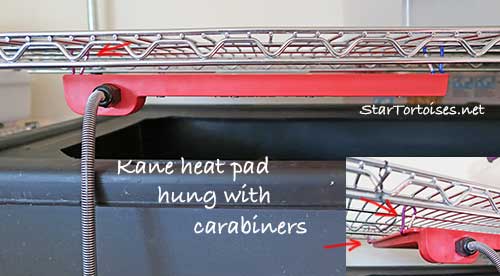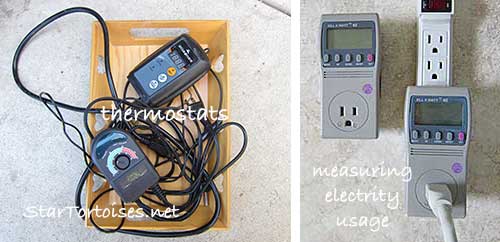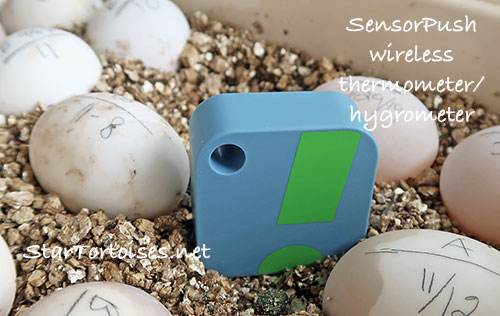


For safety, it's best to buy UL listed and prewired reptile lighting and heating products. Always install heating and lighting devices securely and according to the manufacturer's directions.
Flimsily or otherwise unsafely installed tortoise enclosure fixtures can be fire hazards. Keep hot bulbs away from any flammable materials like enclosure covers, nearby curtains, and any heater or thermometer wires. Also make sure tortoises cannot reach any of those wires and pull the heaters down.
Do install smoke alarms in your tortoise room, garage, cellar, or wherever you keep the enclosures.
You can use reptile basking bulbs, regular household bulbs, or mercury vapor bulbs (MVB's) to create indoor basking areas (see lighting). Create a as large as possible basking area that allows the whole tortoise to warm up. Use "flood" bulbs whenever possible and avoid "spot" bulbs that create small, heated pinpoint areas on tortoises' backs.
Ideally, use a long reptile UVB fluorescent tube and a separate reptile heat bulb for basking heat. Regular household bulbs, CHE's, and radiant heat panels can be used with UVB tubes as well. Always adjust the number and wattage of heat bulbs to fit the size of your enclosure by measuring the warm and cool end temps.
Well-secured light fixtures with ceramic sockets are perfect holders for standard size reptile basking bulbs or regular household light bulbs. Check the wattage rating on the fixture to be sure it takes the wattage of your heat bulb. For example, a typical 5.5" reptile clamp fixture is only rated for a 75W bulb.

Overhead heat is best; belly heat is not recommended for tortoises. Popular heaters used with tortoises include ceramic heat emitters (CHE's), reptile radiant heat panels, and "pig blankets" like the Kane heat mat (18x18 in) above. Zoo Med sells their version of a pig blanket, the 40W ReptiTherm Habitat Heater (18x18 in). It looks like the Kane mat, but is brown in color.
Ceramic infrared heat emitters (CHE's) can be used for overnight heating because they emit no visible light. They can also be used as additional heat sources anytime anywhere. If you use a CHE for daytime basking heat, it needs to be combined with a light emitting bulb, for example, a UVB fluorescent tube.
Be careful as CHE's get VERY hot. They can be installed in wire cage light fixtures, 8"-10" wide reptile brooder light fixtures, or large chicken brooder lamps. Always check that the fixture has a ceramic socket and is rated for your bulb's wattage. Small 5" wide clamp lamps and deep domes are not recommended for CHE's.
Brand new, unused CHE's can emit a slight burning smell when turned on for the first time. I like to pre-burn mine for a few hours before installing them in tortoise enclosures.
The heated basking and warm-up area should be at least as large as the tortoise's shell. CHE's emit heat into a small area, so they work best with little tortoises. CHE's are not recommended for larger tortoises because they can cause spot burns on the shell. Reptile radiant heat panels are a better choice for bigger tortoises.
Reptile radiant heat panels (pic above) are similar in function to CHE's. They both project infrared heat, but radiant heat panels cover much larger areas. CHE's are screwed in like light bulbs, but radiant heat panels are actually shaped like panels. You attach them to the enclosure ceiling for overhead heat. Choose the panel size based on how large of an area you want to heat or how warm you want the enclosure to be.
Reptile radiant heat panels are excellent for vivariums (aka enclosed reptile cages, closed chambers) and heated outdoor tortoise houses. As with other heating devices, always use them with a thermostat, especially when installed in a closed space.
Reptile radiant heat panels are economical to use. Compare the heating surface area in the above photo between the heaters. It shows a 100W CHE and a 80W reptile radiant heat panel. The panel heats a huge area compared to the CHE with the same wattage.

Kane "pig blanket" heat pads do not get very hot because they are designed for little piglets to lie on them. When installed overhead, pig blankets do not warm an area as well as reptile radiant heat panels, but I use them sometimes for gentle night heat. Some people use them as heaters for outdoor tortoise houses and install them on the walls and/or ceiling of the night box. As always, use a thermostat to control the heat, especially when used in small closed spaces like night boxes.
Floor heating is a controversial topic among tortoise keepers. Some like to use small undertank heaters (UTH's) or larger "pig blankets" (rigid floor heat mats) when additional night or day heat is required, while others only recommend overhead heat sources. They feel that bottom heat is unnatural for tortoises and can harm them.
All heating devices, especially UTH's, should be used with a thermostat. Never heat more than 1/4 to 1/2 of the floor space. There must always be unheated floor areas available for the tortoise to cool off.
Caution! Be especially careful if you plan on using UTH's with hatchlings and youngsters. Stuart McArthur's book Medicine and Surgery of Tortoises and Turtles (2004) includes photos of a hatchling with a fractured plastron and ruptured intestines due to heat from an UTH. The author states that he has seen several such cases. According to Dr McArthur, the digestive tract lies unprotected just above the plastron. Belly heat increases digestive processes and can mess up the fermentation process resulting in a ruptured intestine and death.
Installing undertank heat mats and pig blankets on enclosure walls or ceiling to provide radiant heat is fine. Also much safer for the tortoises.
It's always best to use a thermostat or a rheostat with ceramic heat emitters, radiant heat panels, heat mats, and other heating devices to control the temperature level.
A rheostat is a dimmer switch that regulates the flow of electricity on a constant rate based on the user setting. Rheostats work best in rooms where the temperature is relatively stable.
A thermostat (t-stat) turns the heater on and off or regulates the electricity as needed based on the enclosure temperature. A non-proportional thermostat works on an on/off mode, and a proportional thermostat constantly adjusts the amount of heat to keep it at the target level. Ideally, each heating device should have its own thermostat.
Many people like thermostats better than rheostats because t-stats are automatic and will adjust the enclosure temperature if the room temperature goes up and down.
Note: Mercury vapor bulbs (MVB's) cannot be used with dimmers or rheostats, but you can use a timer (automatic on/off) with them.

Hydrofarm and Zilla thermostats (above left) are popular and easily available. You can measure electricity usage with a simple device like the Kill A Watt meter (above right) or any other electricity usage monitor. You simply plug the meter to the wall and the device to the meter.
Using a simple thermostat is straightforward. Plug the heater into the thermostat and the thermostat into the wall outlet. Set the thermostat to the desired temperature level and place the probe to the location in the enclosure where you want to control the heat level.
It's always best to monitor the temperature with a separate thermometer as well to check if any adjustments are needed. The numbers on the t-stat dial can be a bit off the actual readings. In other words, you may need to adjust the t-stat temperature up or down depending on the true temperature in the enclosure.
I have used both Zilla and Hydrofarm t-stats for years. They are reasonably priced and commonly available.
1.) Zilla t-stat
The Zilla temperature controllers (pic above) are simple on/off thermostats with a manual dial. They are available in 1-plug and 3-plug versions to accommodate a different number of heat sources. Similar t-stats are available under various brand names, for example, the Encompass All, A-life, and Esu reptile thermostats look exactly like Zilla's.
2.) Hydrofarm t-stat
Another popular thermostat I use is the Hydrofarm digital thermostat for heat mats (pic above). The newer models have waterproof or water resistant temperature probes that can be exposed to water.
You can plug enclosure lights and heaters into outlet power center timers. Rugged outdoor timers work well, too. This way the tortoise lights will go on and off automatically mornings and evenings. Not a necessary item, but very handy to have.
Caution! Timers and bulbs can fail unexpectedly, so remember to check daily that the timers, lights, and all heaters are working properly. Cold and damp can be detrimental to star tortoises, especially during bitterly chilly nights when outdoors.
You can measure the energy consumption of your reptile bulbs and heaters with an electricity usage monitor. Kill A Watt is a popular, inexpensive meter. It's very easy to use. Just plug it in. You may be quite surprised by the electricity consumption of some bulbs and small appliances.
Out of curiosity, I tested some of my UV and heat bulbs. My 100W MVB's actually use 114-120 watts! In comparison, a 20W T-8 UV tube and a 75W reptile basking bulb use 87 watts combined. My 60W CHE's use about 59 watts, and the 75W reptile basking bulbs use about 72 watts.

The basic SensorPush HT1 digital wireless thermometer / hygrometer (pic) is a popular temperature logger among tortoise keepers. It's small enough to fit in tight spaces like egg incubation boxes. It can be used by itself with Bluetooth or you can purchase a SensorPush gateway to use it with wifi. More advanced, water resistant logger models (HT.w, HTP.xw) and the gateway are available at the SensorPush store on amazon. Though more expensive, those models are great for incubators and humid vivariums (closed chambers).
I use a variety of thermometers and hygrometers. Readings between different types of units can vary, so compare them. Always check the temperatures at both ends of the enclosure to ensure an adequate temperature gradient and also measure the temperature at the substrate level where the tortoise lives.
1.) Dial thermometers
Cheap dial thermometers from pet shops are not very accurate. Their readings can be all over the place. Not recommended.
2.) Digital thermometers
Digital thermometers tend to be more accurate than cheap dial ones. I have a bunch of Acu-Rite temp & humidity monitors. They've become my default thermometer-hygrometers for general use. They have lasted a lot longer than several reptile brands and models I've used. They are inexpensive and seem to be accurate enough for enclosures, usually within 1-2 °F of each other. The humidity readings vary a bit more, about 1-5 % or so.
3.) Hygrometers
Hygrometer readings seem to be more inconsistent than temperature readings. I have a German haar (hair) thermometer in my incubator in addition to a digital one. They are supposed to me more accurate. Ideally, use humidity gauges at both ends of the enclosure as well. Or move the devices around to check the temperatures and humidity at various locations. However, hygrometers tend to be slow to respond.
4.) Temp guns
A hand held temperature gun (temp gun), a digital non-contact infrared thermometer, is another useful gadget to have. It allows you to spot check any surface or bath water temperature in an instant.
5.) Data loggers
Data loggers record data frequently over a long period of time. This allows you to see the exact temperatures over time. Especially useful for incubators and heated outdoor houses. Some are equipped with alarms if the temperature gets too high or low.
The SensorPush wireless thermometer / hygrometers (pic above) are popular among tortoise keepers. The sensor app is compatible with both iPhone and Android devices. Sensors can be used by themselves through a Bluetooth connection or with a separately available SensorPush wifi gateway. The gateway works via internet and gives you constant access to the readings from anywhere.